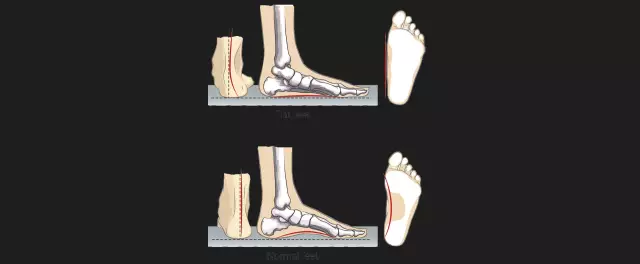- Author Curtis Blomfield [email protected].
- Public 2023-12-16 20:44.
- Last modified 2025-01-23 17:01.
What does the diagnosis "trench foot" mean, not everyone knows. Most people do not even think that catching the disease is very simple. It is enough to get into the habit of walking in tight and wet shoes in cold weather.
Diagnosis "trench foot"
Trench foot in medicine is called a special form of frostbite of the skin of the legs, which is the result of long-term maintenance of limbs in a humid and wet environment. If an ailment is detected, it is important to quickly dry and warm the feet, and also to prevent them from being re-placed in a humid environment. Otherwise, the disease develops rapidly.
Wearing wet shoes in the cold season provokes severe vasoconstriction, and also does not allow the skin of the feet to eat normally, which leads to tissue dysfunction.
First of all, those who regularly keep their legs in a humid environment for a sufficiently long period, and at the same time the limbs are periodically cooled, can pick up the trench foot in the first place. Induring the fighting, foot soldiers, being in the trenches in wet boots, can catch the disease. Also, trench foot is a disease of fishermen and travelers.

How to identify the disease - a description of the clinical picture
This disease is associated primarily with the arteries and disruption of the normal flow of blood in them. Cooling of the legs and their long stay in a humid environment is the first reason for the development of a traumatic disease. The first signs are very vague, it is quite difficult to recognize the severity of the disease at the initial stage. First, an incomprehensible pain felt in the legs appears, and the muscles noticeably weaken. It can be seen that the feet are swollen. The color of the skin changes, cyanosis is acquired. At the very beginning of the disease, the skin of the feet slightly changes color and turns pale, it is moist to the touch, cold comes from it. The pulse is palpable, but it is weak and barely noticeable. With this injury, the course of the disease has a clear sequence. First, nerves and muscle tissue react to cold and dampness, and only after that do external manifestations of the disease appear on the skin.
Patients with this diagnosis say that they feel temporary numbness of the legs, and when trying to rub the skin, pain appears. Especially uncomfortable at night.
Trench foot is a disease that can affect not only the lower, but also the upper limbs.
If the disease is started and left untreated, the consequences can be disappointing. But usually patients seek help immediately after detecting external signs and when pain of an incomprehensible nature appears,associated with muscle weakness.

Stages and degrees of disease
Doctors call 4 degrees of frostbite. The first occurs within a couple of weeks with regular wearing of wet shoes in cold weather. It is not uncommon for the first stage to appear on the third day after being in cold and damp shoes. At the onset of the disease, spontaneous pain occurs in both limbs. They are especially felt in the fingers. It is difficult for patients to walk, they try to step only on the heel. Feet gradually lose sensation. When checking for the Achilles reflex with a medical hammer, there is no reaction. The weakness of muscle tissue at this stage is not due to arterial changes.
After a short period of time, the first stage is replaced by the second. Trench foot is accompanied by severe swelling of the legs. The skin on the fingers begins to turn red. The redness may rise higher to the calf area.
Patients who seek help with primary and secondary signs of injury are successfully cured.
Patients with the third stage of injury are rare. All because no one waits for deterioration and turns to doctors for help in time. During the third stage, blisters appear on the skin, from which a dark liquid may be released. They, bursting, form dense scabs. Such a manifestation of necrosis can spread in width and depth. Over time, the scabs turn into nasty sores that are very difficult and time consuming to heal.
Fourth stage trench foot is considered the most difficult anddangerous. The skin tissue is severely affected, severe necrosis is observed. As a result, an anaerobic infection joins and gangrene develops. In this case, it is impossible to save the person's feet and legs.

Trench foot treatment
Depending on the stage of the trench foot, treatment is prescribed. The first thing to do is to eliminate pain and all malnutrition of the skin. Medicines are prescribed to restore blood circulation in the tissues. Which ones - only the doctor decides. Feet should be gently warmed, but without the use of electrical and heating devices. The patient is placed in such a way that the legs are slightly raised above head level. If lesions are found on the feet, tetanus serum is administered immediately.
Patients with stage 3 and 4 are immediately injected with reopoliglyukin. Bubbles can not be opened, so as not to provoke infection. The liquid from them can be carefully removed by puncture. If gangrene has begun, amputation is prescribed.

How to protect yourself from illness
Trench foot is an unpleasant disease. It is better to prevent it than to cure it. It is important to wear shoes that are dry and loose, to prevent hypothermia of the extremities. It will not be superfluous to constantly change socks. And in cases of the appearance of the described signs, consult a doctor and be treated.






